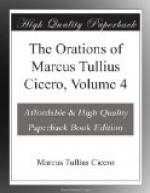VII C. F. It remains, then, now for you to speak of the alterations and changes in a speech.
C. P. The whole of that, then, consists in the alteration of words, and that alteration is managed in such a way in the case of single words, that the style may either be dilated by words, or contracted. It may be dilated, when a word which is either peculiar, or which has the same signification, or which has been coined on purpose, is extended by paraphrase. Or again, in another way, when a definition is held down to a single word, or when expressions borrowed from something else are banished, or made use of in a roundabout sense, or when one word is made up out of two. But in compound words a threefold change can be made, not of words, but only of order, so that when a thing has once been said plainly, as nature itself prompts, the order may be inverted, and the expression may be repeated, turned upside down, as it were, or backwards and forwards. Then again the same expression may be reiterated in a mutilated, or re arranged, form. But the practice of speaking is very much occupied in all these kinds of conversion.
C. F. The next point is action, if I do not mistake.
C. P. It is so, and that must be constantly varied by the orator, in correspondence with the importance of his subjects and of his expressions. For the orator makes an oration clear, and brilliant, and probable, and agreeable, not only by his words, but also by the variety of his tones, by the gestures of his body, by the changes of his countenance, which will be of great weight if they harmonize with the character of his address, and follow its energy and variety.
C. F. Is there nothing remaining to be said about the orator himself?
C. P. Nothing at all, except as to memory, which is in a certain manner the sister of writing, and though in a different class greatly resembles it. For as it consists of the characters of letters, and of that substance on which those characters are impressed, so a perfect memory uses topics, as writing does wax, and on them arranges its images as if they were letters.




